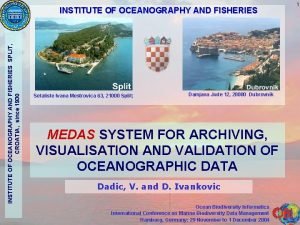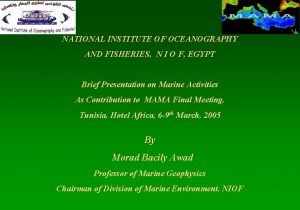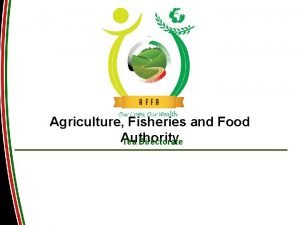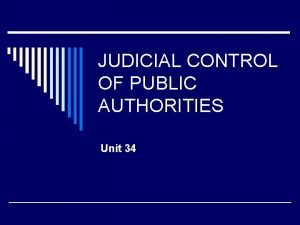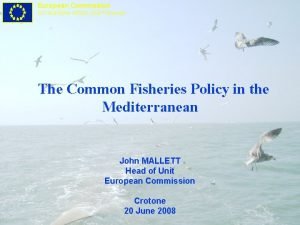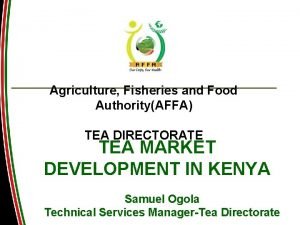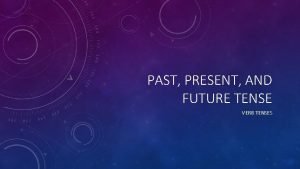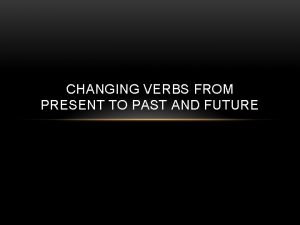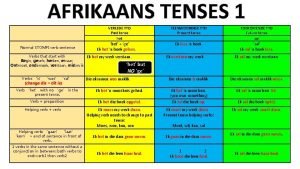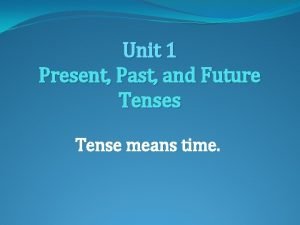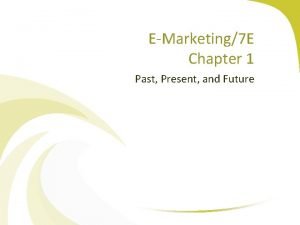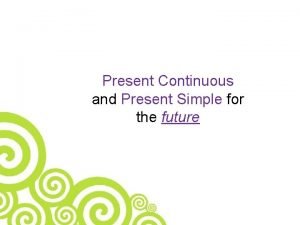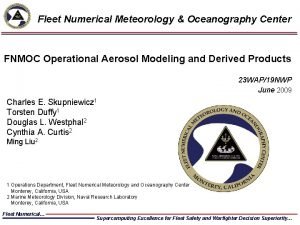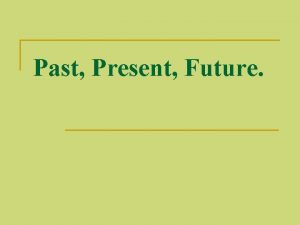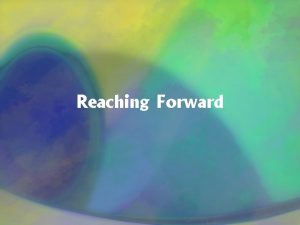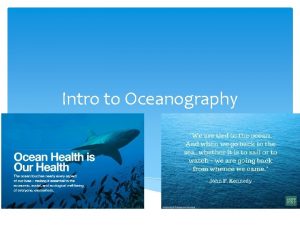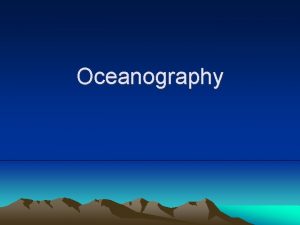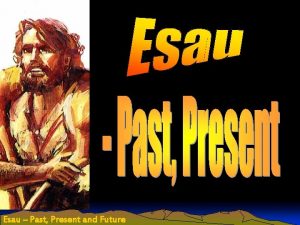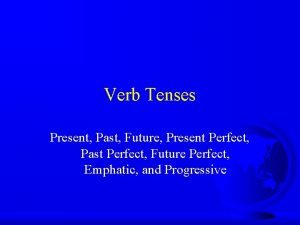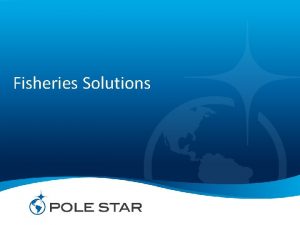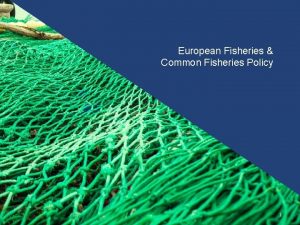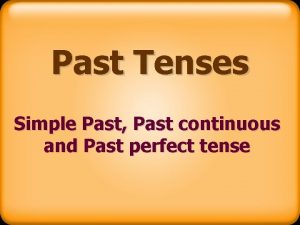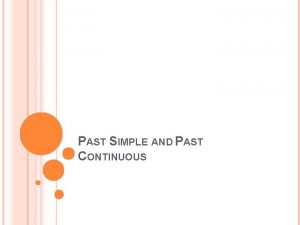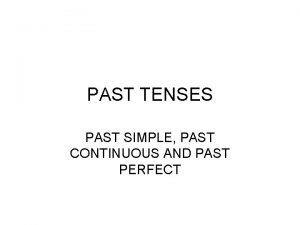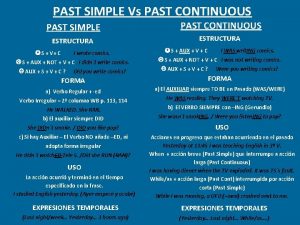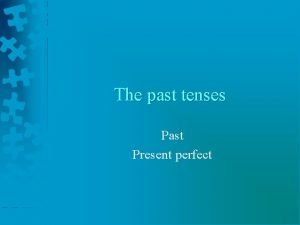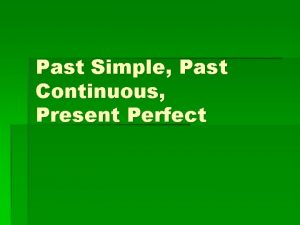The Past Present and Future of Fisheries Oceanography

























- Slides: 25

The Past, Present and Future of Fisheries Oceanography: Refashioning a Responsible Fisheries Science

Contents Introduction 2. Reinventing resource management 3. Merging science and management back into fish trafficking 4. System science as an alternative 5. Critical thinking, observational data and presumptions 6. Principal features of today’s major fisheries and habitat disasters 7. Defining ecosystems by their production patterns 8. The objective of science is to forecast, not just hindcast 9. Someday. . . 10. Getting the questions right 11. Scenarios from the past for the future 1.

Introduction p Symposium purpose n n p To assess available fisheries management tools To suggest solutions that would help renovate fisheries science Conventional fisheries science as implemented in related resource management has failed! Why? n n weak population assessment tools little of what is known about any fish or the related ecosystem ⇛ El Niño? ; Regime Shift? Etc. Strong external causes of the initial declines p n Market-driven greed Fishing per se is not where the major profits are made in fish trade

question p The question is not why fisheries are in collapse, so much as what can be done about it. n Resolve the control over catch rates, and the allocation of fishes, and stabilize fisheries: p p n n n MSY & Equilibrium population modeling theories Continuous disequilibrium in nature; steady state The traditional concern fish trade based on laisses faire capitalism, free market structures, and the resulting dwindling resources with escalating values How to control throughput at the marketplace To understand fisheries variability – p + Full knowledge of the environmental forcing and ecological responses within which fisheries operate

Reinventing resource management p The social impetus of cod fishing n n p p There need to be many changes… Definitions of problems associated with the science n n p p p Newfoundland cod – recent fiasco An indictment against arrogant science Natural variations of ecosystems over which humans have no control The rampant lack of concern over downstream process by land developers create unnecessary problems Communications and cooperative interactions between concerned natural and physical science communities, fishermen, marketers, and fisheries managers to affect rational resource exploitation Local subsistence fishing cultures - lost General need for attitude adjustment - new fisheries science and fishermen’s direct involvement

Merging science & management Observation drive good decisions 2. Best available science 3. Ecosystem-based resource management. 4. The education of new generation of fisheries resource scientists 5. A short history of population assessment modeling 6. Predator-prey and habitat complexity 7. Ocean climate and fisheries 8. Tides and other natural factors vs simplified behavior models 9. The ecological cascade 10. Quantification techniques: tools, not ends unto themselves 11. Stakeholder’s objectives differ 1.

System science as an alternative Applied economics of nature p Human withdrawals and inputs human enterprises (Lubchenko. 1998) n n Transform the land sea II. Alter the major biogeochemical cycles III. Add or remove species I. The fisheries ecosystem p Resource economics and ecology n p p n n In-depth knowledge + Real-time cost accounting: all resources All resources used in basic fish capture, preservation methods transport and preparations for market outlets + (pollutants) Conventional market-driven economic decision-making Cost of non-renewable; losses of support system Costs to catch vs. landed value – exceed cur-off points More is lost than is gained

System science as an alternative Step one: defining ‘the problem’ p n 1. Slivert (1993) size-spectra models Size-structured simulation models 1. 2. 3. 4. 5. 6. n n Ecosystem dynamics and their responses to environmental factors Size-structured models - estuarine and continental shelf systems Energy flow; size spectrum from small to large Multi-stable complex behavior Not answer all questions Essential tool Each resource populations’ growth and reproduction is optimized ‘Harvesting’ vs ‘mining’ – self sustaining populations

System science as an alternative 1. Step one: defining ‘the problem’ 2. What do we need to know? n Basic survival requirements of each species’ developmental stages p n n Life history survivorship problem Larval fish survival (S) Total Natural mortality (Z), Fishing Mortality (M) Survival: 1 – (Z+M) ≠ S

System science as an alternative 1. Step one: defining ‘the problem’ ; 2 What do we need to know? The microcosm – the critical period hypotheses 3. 1. Reinvention of the early life-history survival 1. 2. 3. 4. 5. 2. Modern stock enhancement and put-and-take fisheries science Prey (food) production - physical-biological interfaces Painstaking, trial-and-error lab works – life histories The ‘critical period’ concepts Lasker’s ‘Stability-survival hypothesis’ ‘Lasker Window’ (Bakun, 1996) Tools : Bat. FISH; BIONESS Plankton samplers; Owen’s microsampler 1. 2. Ocean dynamics well beyond usual observations, or expectations Each sample cast or sample interval was unique!

System science as an alternative 1. Step one: defining ‘the problem’ 2. What do we need to know? 3. The microcosm The macrocosm 4. n Ecosystem thinking p p Integrate several trophic components + competitor fish sp. + bottom-up trophic components ; analogy of chemical transfers Fish population respond to climatic patterns, with or without fishing: equilibrium? ? The assumption of persistence (i. e. equilibrium) has no place in population biology, fisheries assessments, or probable anywhere outside a lower division classroom.

System science as an alternative 1. Step one: defining ‘the problem’ 2. What do we need to know? 3. The microcosm 4. The macrocosm So – what is the question? 5. n What causes these ecosystem variations? p p n Description and measurement of environmental conditions that permit survival (mortality) of various species Species interactions + Cascades of energy and materials Final conclusion 1. 2. 3. 4. 5. 6. Time and space scales Interactions between species - scales Trends and regime shifts – behavior and age distributions Survival at early life-history stages Mortality No single measure - decision-making

System science as an alternative Early Life History Survival issues Ocean Science in Support of Living Resources Programme (OSLR) Climate-Ocean Resources variability Field criteria and assays GLOBEC 1. 2. 3. 4. 5. 1. 6. 7. 8. Reach beyond zooplankton dynamics to fisheries LME BEP …



Critical thinking, observational data, and presumptions After early life-history issues, what are the basic questions? p The fisheries efficiency problem p

Lesson p 1. 2. 3. A consequence of fleet expansions: As fishers upgrade their technologies, costs decline up to a point, after which economic efficiencies may decline. Quality of life at sea may improve, but durations of time spent at sea usually increase. There is not enough of any resource of ‘sustained growth’

Principal features of today’s major fisheries and habitat disasters Human population issues p Misuse of habitat, development’s role in fishery declines p Upstream, downstream p

Defining ecosystems by their production patterns Is the question really how much fish is there? p Open systems – ocean habitats, and species mobility p

The objective of science is to forecast, not just to hindcast p Ongoing success stories

Someday… Market-based management p Information needs of the new fisheries science p

Getting the questions right p Fisheries vary – and management can work, Now what?

1) Definition of the fishery system, and identifying all external physical forcing is imperative to understanding ecosystem function and sustainability 2) Ecosystem stability is neither attainable, nor desirable; 3) We need true-time environmental monitoring, as well as accounting of production costs 4) Socially acceptable management will necessarily involve the re-integration of fisherfolk and scientists

5) Cascading food webs and bottom-up ecologically correct production models need to meet. 6) Who is in charge? 7) Don’t waste resources! 8) Incentives!

Scenarios from the past for the future
 Split institute of oceanography and fisheries
Split institute of oceanography and fisheries Institute of oceanography and fisheries
Institute of oceanography and fisheries Present simple present continuous past simple future simple
Present simple present continuous past simple future simple Simple past simple present simple future
Simple past simple present simple future презент перфект упражнения
презент перфект упражнения Present simple future
Present simple future Future continuous and future perfect simple
Future continuous and future perfect simple Future perfect e future continuous
Future perfect e future continuous Past perfect continuous past continuous
Past perfect continuous past continuous Tea directorate
Tea directorate Ministry of food agriculture and fisheries denmark
Ministry of food agriculture and fisheries denmark Allingham v minister of agriculture and fisheries
Allingham v minister of agriculture and fisheries Dg maritime affairs and fisheries
Dg maritime affairs and fisheries 399
399 Present past and future continuous
Present past and future continuous Future tense jump
Future tense jump Verbs present past and future
Verbs present past and future Examples of present tense in afrikaans
Examples of present tense in afrikaans Past tense of breeze
Past tense of breeze Simple present past and future
Simple present past and future Simple present simple future
Simple present simple future E marketing past present and future
E marketing past present and future Timetable present continuous
Timetable present continuous Present perfect simple vs past continuous
Present perfect simple vs past continuous Past perfect vs past continuous
Past perfect vs past continuous Fleet numerical meteorology and oceanography center
Fleet numerical meteorology and oceanography center
